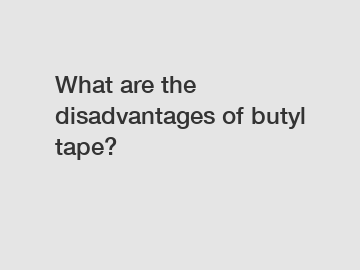What are the disadvantages of butyl tape?
Butyl tape is a popular adhesive used in various industries for sealing and bonding applications. It offers many benefits, such as easy application, excellent adhesion, and flexibility. However, like any product, butyl tape also has its disadvantages. Understanding these drawbacks can help users make informed decisions when choosing the right adhesive for their projects.
### Durability.
Butyl tape is known for its excellent adhesion and waterproofing properties. However, one of the main disadvantages of butyl tape is its durability. Over time, butyl tape can degrade and lose its adhesive properties, especially when exposed to harsh environmental conditions such as extreme temperatures, UV radiation, and moisture. This can lead to the tape becoming brittle, cracking, or peeling off, compromising the integrity of the seal or bond.

### Compatibility Issues.
Another drawback of butyl tape is its limited compatibility with certain materials. Butyl tape is not recommended for use with some plastics, such as PVC, as it can cause chemical reactions that weaken the bond. Additionally, butyl tape may not adhere well to surfaces with textures or coatings, reducing its effectiveness. It is essential to ensure that butyl tape is compatible with the materials you are bonding or sealing to avoid adhesion failures.
### Limited Temperature Resistance.
Although butyl tape is suitable for a wide range of temperatures, it has a limited temperature resistance compared to other adhesive options. Butyl tape may soften or melt at high temperatures, affecting its adhesive properties. Similarly, at low temperatures, butyl tape can become stiff and lose flexibility, making it challenging to apply or seal properly. Users should consider the temperature requirements of their application to determine if butyl tape is the right choice.
### Not Suitable for Load-Bearing Applications.
One significant disadvantage of butyl tape is that it is not suitable for load-bearing applications. Butyl tape is a sealing and bonding adhesive designed for creating airtight and watertight seals. It lacks the strength and structural support needed for applications where heavy loads or pressure are involved. If used in load-bearing situations, butyl tape may fail, leading to leaks or structural instability.
### Limited Aesthetic Appeal.
While butyl tape is highly effective for sealing and bonding, it may not be the most aesthetically pleasing option. The appearance of butyl tape, especially when used in visible areas, may not be desirable as it can be thick, uneven, and difficult to conceal. For projects where aesthetics are crucial, such as in architectural or design applications, butyl tape may not be the best choice.
### Conclusion.
In conclusion, butyl tape offers many benefits as an adhesive for sealing and bonding applications. However, it is essential to consider the disadvantages of butyl tape before using it for your projects. Durability issues, compatibility limitations, temperature resistance, load-bearing capacity, and aesthetic concerns are factors to keep in mind when deciding whether butyl tape is the right choice for your application. By understanding these drawbacks, users can make informed decisions and explore other adhesive options that better suit their needs.
For more information on butyl tape and other adhesive solutions, please contact us.
Want more information on Polypropylene Bitumen Tape Supplier, 1027 liquid adhesive primer, anti corrosive pipe wrapping tape? Feel free to contact us.

Comments
0